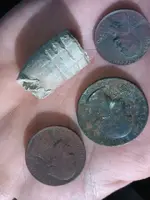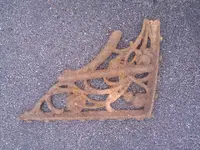You are using an out of date browser. It may not display this or other websites correctly.
You should upgrade or use an alternative browser.
You should upgrade or use an alternative browser.
didnt expect to find one of these...
- Thread starter bountyhuntergirl86
- Start date
Argentium
Gold Member
- Joined
- Feb 2, 2008
- Messages
- 9,058
- Reaction score
- 5,575
- Golden Thread
- 0
- Location
- Santa Fe, New Mexico
- Detector(s) used
- Whites, MXT.
- Primary Interest:
- All Treasure Hunting
Are all those three ringers Civil War period ,or did they continue them for a while ? Did you find anything cool on your roadtrip ?
bountyhuntergirl86
Bronze Member
- #3
Thread Owner
as far as I know and there were to many people combing the beach just found some wore out clad. and I was pretty wasted most the time lol
bountyhuntergirl86
Bronze Member
- #4
Thread Owner
RelicPrime113
Full Member
- Joined
- Aug 20, 2013
- Messages
- 211
- Reaction score
- 122
- Golden Thread
- 0
- Location
- Massachusetts
- Detector(s) used
- Bounty Hunter Quick Silver, Teknetics Delta 4000
- Primary Interest:
- All Treasure Hunting
Those are awesome finds
Tenspeed
Hero Member
- Joined
- Mar 22, 2009
- Messages
- 518
- Reaction score
- 219
- Golden Thread
- 0
- Location
- York County, SC
- Detector(s) used
- Currently: Minelab Equinox 800, Minelab CTX 3030, Minelab E-Trac, Garrett Pro Pointer AT
Past: XP Deus, Xterra 70, Ace 250
- Primary Interest:
- All Treasure Hunting
three ringers are always neat to find.
WHADIFIND
Gold Member
- Joined
- Apr 9, 2012
- Messages
- 12,386
- Reaction score
- 40,970
- Golden Thread
- 1
- Location
- South of the Mason-Dixon Line
- 🥇 Banner finds
- 1
- 🏆 Honorable Mentions:
- 4
- Detector(s) used
- Garrett AT-MAX
Garrett AT-PRO,
Garrett Groundhog,
Pro-Pointer,
Jack Hammer!
- Primary Interest:
- All Treasure Hunting
Well, even back then, when they fired a shot into the air to celebrate. It had to come down somewhere. 
Nice!

Nice!
arrowhead82
Sr. Member
- Joined
- Dec 12, 2012
- Messages
- 334
- Reaction score
- 86
- Golden Thread
- 0
- Detector(s) used
- Garrett AT Pro and Garrett Pro pointer
- Primary Interest:
- Relic Hunting
nice bullet! looks rifled so it's probably post CW. also I like the part to a school desk!  nice finds!
nice finds!
HH
 nice finds!
nice finds!HH
Petrie502
Bronze Member
- Joined
- Sep 2, 2012
- Messages
- 1,115
- Reaction score
- 432
- Golden Thread
- 1
- Location
- Louisville Kentucky
- 🥇 Banner finds
- 1
- Detector(s) used
- UNITED STATES MARINE CORPS (Combat Marine retired)
SEMPER FIDELIS
- Primary Interest:
- Metal Detecting
Yep sorry coily it's post civil war it you guns me the weight and measurments I can possibly tell u a time frame
jtomlinson
Full Member
Awesome finds !!!!! that old desk part is cool
CoilyGirl
Gold Member
Yep sorry coily it's post civil war it you guns me the weight and measurments I can possibly tell u a time frame
Bounty Hunter Girl posted this,not me Petrie.hey I like that old bracket BHG.
bountyhuntergirl86
Bronze Member
- #13
Thread Owner
Bounty Hunter Girl posted this,not me Petrie.hey I like that old bracket BHG.
lol that's funny got us ladies mixed up :-) I figured it was post cw I noticed it looked like maybe a carbine rifle fired it... and thanks girl I find those desk pieces at every school I detect...
brnn53
Hero Member
- Joined
- Mar 31, 2006
- Messages
- 631
- Reaction score
- 7
- Golden Thread
- 0
- Location
- North Carolina
- Detector(s) used
- Gold Bug, Tejon, T2 LTD, F75, & Nautilus DMC II B
- Primary Interest:
- Relic Hunting
There was a CS hospital there so if that is a 3 ringer its period. Nice find!
Mike
Mike
bountyhuntergirl86
Bronze Member
- #15
Thread Owner
kittrell school in murfreesboro TN?
TheCannonballGuy
Gold Member
- Joined
- Feb 24, 2006
- Messages
- 6,607
- Reaction score
- 13,455
- Golden Thread
- 0
- Location
- Occupied CSA (Richmond VA)
- Detector(s) used
- White's 6000, Nautilus DMC-1, Minelab
- Primary Interest:
- Relic Hunting
I received a PM asking me to reply to various comments in this discussion. Here are my replies, in no particular order.
The bullet appears to be a fired yankee "generic" 3-groove Minie-ball... and based on size comparison with the quarter-dollar it seems to be a .58-caliber one.
In bullet-identification, the term "ring" has a different meaning than "groove." A ring is raised (like a wedding-ring around your finger), and a groove is indented. But relic-diggers have been calling the Minie-ball found by Bountyhuntergirl a "3-ringer" for over 50 years, so getting them to change to the correct bullet-ID terms probably isn't going to happen.
Rifling-marks on the bullet does not automatically mean it is from after the civil war. Beginning with the Model-1855 Springfield Rifle, the US Army issued rifled guns to its troops. The majority of yankee troops in the civil war were armed with rifled guns.
In response to Argentium's question:
Yes, Minie-balls were used in America for many years after the end of the civil war. When the war ended, the US Army began replacing its Minie-ball-firing muzzleloader rifles with metal-cartridge-firing breechloaders, and it sold vast quantities of the no longer needed war-surplus muzzleloader rifles to the public for game-hunting. For example... reportedly, famous World War One sharpshooter Sgt. Alvin York used a Minie-ball-firing civil war muzzleloader rifle for deer-hunting when he was a teenager in the Tennessee mountains, around 1900. Therefore, we relic-diggers have to do our best to find out if there was any civil war combat (or raw-recruits firearms training) in the area where we've dug a fired Minie-ball.
The bullet appears to be a fired yankee "generic" 3-groove Minie-ball... and based on size comparison with the quarter-dollar it seems to be a .58-caliber one.
In bullet-identification, the term "ring" has a different meaning than "groove." A ring is raised (like a wedding-ring around your finger), and a groove is indented. But relic-diggers have been calling the Minie-ball found by Bountyhuntergirl a "3-ringer" for over 50 years, so getting them to change to the correct bullet-ID terms probably isn't going to happen.
Rifling-marks on the bullet does not automatically mean it is from after the civil war. Beginning with the Model-1855 Springfield Rifle, the US Army issued rifled guns to its troops. The majority of yankee troops in the civil war were armed with rifled guns.
In response to Argentium's question:
Yes, Minie-balls were used in America for many years after the end of the civil war. When the war ended, the US Army began replacing its Minie-ball-firing muzzleloader rifles with metal-cartridge-firing breechloaders, and it sold vast quantities of the no longer needed war-surplus muzzleloader rifles to the public for game-hunting. For example... reportedly, famous World War One sharpshooter Sgt. Alvin York used a Minie-ball-firing civil war muzzleloader rifle for deer-hunting when he was a teenager in the Tennessee mountains, around 1900. Therefore, we relic-diggers have to do our best to find out if there was any civil war combat (or raw-recruits firearms training) in the area where we've dug a fired Minie-ball.
bountyhuntergirl86
Bronze Member
- #17
Thread Owner
I received a PM asking me to reply to various comments in this discussion. Here are my replies, in no particular order.
The bullet appears to be a fired yankee "generic" 3-groove Minie-ball... and based on size comparison with the quarter-dollar it seems to be a .58-caliber one.
In bullet-identification, the term "ring" has a different meaning than "groove." A ring is raised (like a wedding-ring around your finger), and a groove is indented. But relic-diggers have been calling the Minie-ball found by Bountyhuntergirl a "3-ringer" for over 50 years, so getting them to change to the correct bullet-ID terms probably isn't going to happen.
Rifling-marks on the bullet does not automatically mean it is from after the civil war. Beginning with the Model-1855 Springfield Rifle, the US Army issued rifled guns to its troops. The majority of yankee troops in the civil war were armed with rifled guns.
In response to Argentium's question:
Yes, Minie-balls were used in America for many years after the end of the civil war. When the war ended, the US Army began replacing its Minie-ball-firing muzzleloader rifles with metal-cartridge-firing breechloaders, and it sold vast quantities of the no longer needed war-surplus muzzleloader rifles to the public for game-hunting. For example... reportedly, famous World War One sharpshooter Sgt. Alvin York used a Minie-ball-firing civil war muzzleloader rifle for deer-hunting when he was a teenager in the Tennessee mountains, around 1900. Therefore, we relic-diggers have to do our best to find out if there was any civil war combat (or raw-recruits firearms training) in the area where we've dug a fired Minie-ball.
thank you very much for the information. I see what u mean by grove instead of ring, I noticed that myself when I found it I thought maybe the rings had been smoothed out from it bring fired from a different type of rifle. when u say yankee fired do u mean cw union?
Last edited:
treblehunter
Gold Member
- Joined
- Jun 18, 2013
- Messages
- 9,675
- Reaction score
- 11,296
- Golden Thread
- 0
- Location
- New Jersey
- Detector(s) used
- Minelab Excalibur II
XP Deus
Garrett pro pointer
XP Deus MI-6 pinpointer
- Primary Interest:
- All Treasure Hunting
Cool bullet, nice finds, you go girl!
TheCannonballGuy
Gold Member
- Joined
- Feb 24, 2006
- Messages
- 6,607
- Reaction score
- 13,455
- Golden Thread
- 0
- Location
- Occupied CSA (Richmond VA)
- Detector(s) used
- White's 6000, Nautilus DMC-1, Minelab
- Primary Interest:
- Relic Hunting
Bountyhuntergirl86 wrote:
> when u say yankee fired do u mean cw union?
Yes.
> when u say yankee fired do u mean cw union?
Yes.
bountyhuntergirl86
Bronze Member
- #20
Thread Owner
that's cool thanks so much...
Similar threads
- Replies
- 14
- Views
- 497
- Replies
- 10
- Views
- 462
Users who are viewing this thread
Total: 1 (members: 0, guests: 1)



